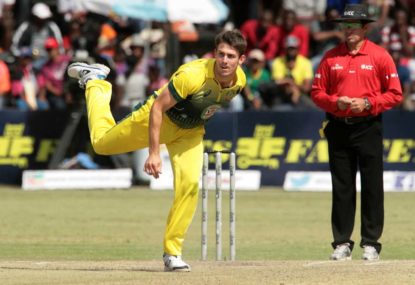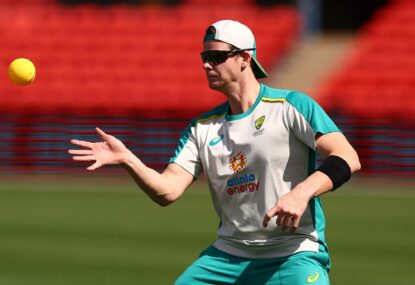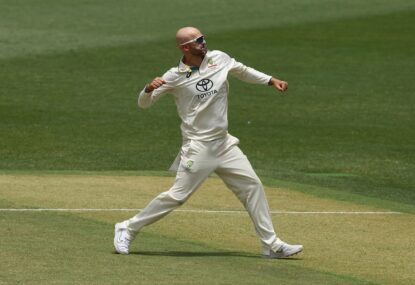After their humiliation in the first match of the series, Australia headed to Wellington Stadium, named after young leg-spinner and WBBL sensation Amanda Wellington, desperate to hit back. And hit back desperately they did, defeating New Zealand by four wickets, with 21 balls in hand.
Here are the ratings from the second ODI.
Team Selection
Grade: B+
Australia were forced to make three changes to their team from the first game. James Faulkner was out, hamstrung by his hamstring injury. Shaun Marsh was also out, having been finally Usmanhandled. And, of course, Kane Richardson was not permitted to play as it would put this ODI over the ICC’s standard Kane Match Quota (KMQ).
The major beneficiary of these changes was debutant Adam Zampa, whose bowling variations were enthusiastically endorsed by captain Steve Smith at the toss. Disappointingly, however, Smith failed to mention the one where Zampa runs out the non-striker with his face.
More cricket:
» Matthew Wade must not be picked for the World T20
» John Hastings’ blood is worth bottling
» Marsh delivers series-levelling ODI win
» Scorecard: New Zealand vs Australia second ODI
» Watch: Second ODI highlights
Come on, Skip! Back your man!
On the other hand, New Zealand went into the game with the exact same line-up as in the first game. Presumably, they were banking on the fact that any team with a top five all with ‘LL’ in their surname (Brendon McCullum, Martin Guptill, Kane Williamson, Henry Nicholls and Grant Elliott) deserve to win a match at WeLLington.
Letters
Grade: a letter
Bolstered by the confidence in his double-L top order, McCullum belligerently pillaged, brilliantly drilling half-volleys, pulling all balls powerfully and, uh, playing a lot of other shots that are less easily described with double-L words.
But no. Of course, McCullum’s onslaught has nothing to do with this double-L based top order, as logical as that might seem to the rest of us. He has, after all, been batting in this aggressive, untraditional fashion for ages now.
Strange, really, to see such disrespect for safety-first opening and other cricketing traditions from a man who also has the first three letters of his surname spell out ‘MCC’.
Umpiring Priorities
Grade: C
McCullum was eventually dismissed, bowled by Boland for 28 off 12 balls. In the process, Boland earned himself figures of 1/6 off 2 balls, which is arguably one of the very best set of bowling figures to have.
From there, wickets fell steadily throughout the New Zealand innings, never really collapsing, but never really getting away either.
One of the ploys Australia used to prevent New Zealand from accelerating too much was regular changes of bowling angle. At one point, Glenn Maxwell bowled from an angle wide enough to raise questions of the prospect of a back foot no ball.
This went unnoticed by umpire Billy Bowden, who was busy celebrating his two hundredth ODI and, coincidentally, his 100,000th idiosyncratic scoring signal.
A tremendous feat and congratulations to him, but umpires should surely be keeping a closer eye on back foot no balls. Also, front foot no balls. And they should focus on chucking too. And also making sure the correct number of players are inside the circle.
Sure, that’s a lot to keep an eye on as the ball is being delivered. So why not let the players sort out the other end? Implement the honour system for all wickets and make things simpler for everybody.
Usman Khawaja
Grade: B
With New Zealand finally spluttering their way to 9/281 off their fifty overs, Usman Khawaja walked out to open with David Warner.
His omission from the first game had been one of the most talked about cricketing matters of the previous few days. Well, that, and the Mankad at the Under 19 World Cup.
Could Khawaja raise the talked-about bar even further, by succumbing to his own Mankad, perhaps? An Us-Mankad-whaja, if you will.
No. That was too much to ask for. But as Khawaja and Warner raced to a 122 run opening partnership off just 16.2 overs, it became clear that even sporting portmanteaus – or sportmanteaus – were conspiring against Rod Marsh’s innate desire to select Shaun. ‘Khawarner’ just sounds so much better than ‘Warsh’.
Still, the Khawarner partnership was eventually broken, with Khawaja caught and bowled for fifty by Mitchell Santner. With Khawaja’s weakness against spin so cruelly exploited by New Zealand, is it time to give Shaun Marsh another chance?
I say yes.
Boredom
Grade: D
One day cricket’s problem for many years now has been its infamous ‘boring middle overs’, where batsmen are content to just gather singles, while the bowlers and fielders are equally content to let them do so.
Australia, ever the ODI innovators, completely rid themselves of the notion of boring middle overs here, losing Steve Smith, George Bailey, Glenn Maxwell and Matthew Wade for ten runs between them.
With John Hastings joining Mitchell Marsh at the crease, six wickets down and 85 runs still to get, the chase was not boring, but New Zealand had become favourites to win.
But Australia had yet another trick up their sleeve. They’d eliminated the boring middle overs with their collapse. But the early overs had also reduced the required run rate to something sufficiently trivial that they could now develop the concept of boring death overs instead.
Marsh and Hastings therefore strolled comfortably to the brink of victory via easy singles until the game was eventually won by consecutive blasted fours by Hastings.
Or, to use his new title, John ‘The Finisher’ Hastings.






































































































